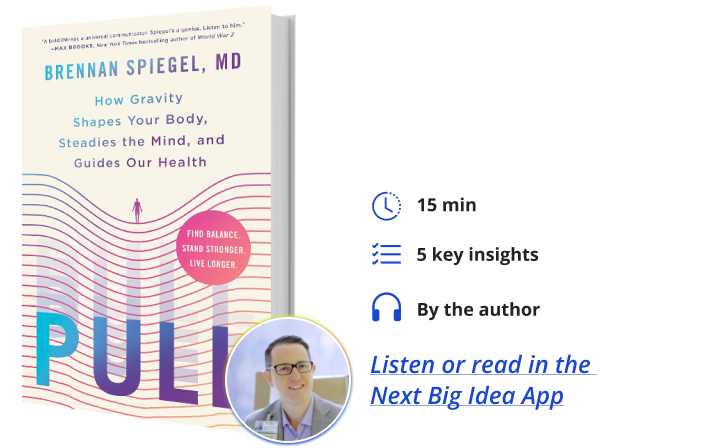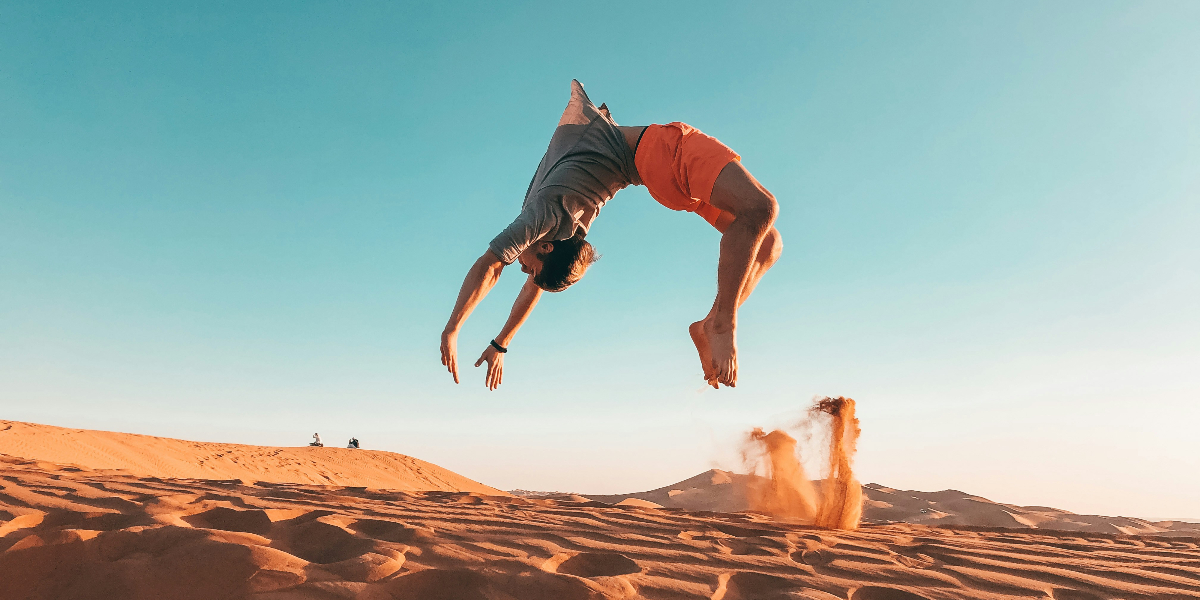Below, Dr. Brennan Spiegel shares five key insights from his new book, PULL: How Gravity Shapes Your Body, Steadies the Mind, and Guides Our Health.
Brennan is a physician and professor of medicine who studies how emotion, physical experience, and the mind-body connection influence health. He directs Health Services Research at Cedars-Sinai.
What’s the big idea?
Gravity shapes more than planets and stars; it shapes human health in ways medicine is still uncovering. PULL explores how gravity shapes both body and mind, and how we can build gravity resilience to stand stronger, live longer, and thrive under Earth’s constant pull.

1. We all navigate gravity differently—and we can get better at it.
The idea for this book began at a family dinner. My wife was worried about her mom—ever since moving to assisted living, she’d developed stomach bloating, slow digestion, and a low mood. Her diet and meds were unchanged. What had changed was her relationship with gravity: she spent most of the day lying down. That worried me, because without standing and moving, the gut slows down. Humans aren’t meant to lie flat all day. We’re built to stand up.
I dove into the science of how gravity affects digestion. My hunch eventually became a research article titled “Gravity and the Gut,” which unexpectedly drew international coverage. Soon, my inbox was full of people who suspected “gravity intolerance” was behind their symptoms.
Some felt dizzy or faint when standing too quickly, calling themselves “allergic” to gravity. Others had inner-ear issues that triggered vertigo and anxiety by throwing off their sense of gravity’s pull. People swore by wedge pillows to ease nighttime heartburn. Families described loved ones in hospital beds declining from too much time flat—losing muscle, developing clots, constipation, bedsores, and even confusion.
Doctors weighed in, too. A rehab physician showed X-rays of spinal adjustments that eased bowel strain by strengthening anti-gravity muscles in the back. A GI doctor linked high-altitude travel to colitis flare-ups from gravity-dependent pressure changes. A neurologist explained how stroke recovery depends on position during transport to the hospital; it turns out it’s better to stay flat so blood reaches the brain.
The good news is that whatever genes you have, you can improve your “gravity resilience.” Each of us can find a personal Gravity Goldilocks Zone. Movement, sleep, diet, inverted yoga poses, tilt tables, standing desks, balance boards, floatation therapy—these aren’t fads. They’re tools for thriving under Earth’s pull.
2. Stand up to gravity.
When we give in to gravity by lying too long or sitting for hours, our bodies start to break down. Even the strongest people, like astronauts, lose bone, muscle, and cardiovascular strength in microgravity, which is why NASA makes them work out for hours each day aboard the ISS. On Earth, sedentary living is so harmful that sitting is now called “the new smoking.”
Knowing this, I decided to take a literal stand against gravity’s toll. To the confusion of family, friends, and colleagues, I spent eight weeks simulating life on a planet with stronger gravity by strapping on a 20-pound vest and 10-pound ankle weights from morning to night while working at my standing desk and balance board. At first, my back ached, and my legs burned. But over time, my body adapted: I tripled my squat count, climbed stairs more easily, lost four pounds without changing my diet, and even eased years of neck pain.
“Resisting gravity makes us stronger, but sometimes adding a little extra load can make us more resilient than we thought possible.”
Science offers a clue why. Swedish researchers discovered the gravitostat, a weight-sensing system in our bones that helps regulate energy balance. In studies, both rats and humans carrying extra weight burned more fat without losing muscle. It’s the principle behind rucking—walking with a weighted backpack—which builds strength, boosts cardiovascular health, and can even curb appetite. Resisting gravity makes us stronger, but sometimes adding a little extra load can make us more resilient than we thought possible.
3. Lighten your mental load.
Imagine waking up on a planet with gravity twice as strong as Earth’s. Even getting out of bed feels like climbing a hill. By the time you’re dressed, you’re exhausted. Your posture sags, your gaze drops, and even conversation feels like work.
That’s what depression can feel like. Australian neuroscientist Lachlan Kent calls it mental gravity, a force that pulls you down, slows you, and makes time itself drag. He likens it to an emotional black hole: just as gravity bends space and time, depression warps perception, making the world feel heavier, slower, smaller.
It’s more than a metaphor. Our nervous system constantly measures gravity’s pull through a process called graviception. Emotions change that perception: joy and love can make us feel lighter; sadness or fear can make us feel heavier. Language mirrors this: being “up” signals vitality and hope, while being “down” implies defeat.
We can push back. Standing tall—shoulders back, head up—can improve mood and even shift stress hormone levels. Yoga postures, “anti-gravity” meditations, and simply lifting your gaze toward the sky can create a literal and figurative sense of lightness.
One way to tap into this is to simulate rising. In virtual reality, people can float over a lake or soar into the sky. In a study I co-authored, this lowered heart rate, reduced stress hormones, and eased emotional distress—proof that the mind can make the body feel lighter without physical lift.
Floatation therapy works too: lying in warm, buoyant saltwater lowers blood pressure, slows the heart, and frees the mind for deep relaxation, creativity, and timeless flow. Sometimes the best way to stand up to gravity is to simply float above it.
4. Trust your gut—it’s a gravity alarm.
As a gastroenterologist, I see plenty of “gut feelings.” Sometimes we find a cause, like inflammation or ulcers, but often every test is normal, yet the gut keeps sending urgent signals.
One trigger sets it off in almost everyone: falling. Think of a roller coaster drop or a sudden jolt in an elevator. These moments are primal alarms. Our bellies hold an ancient g-force sensor that’s been protecting us since birth.
“The same circuitry fires when we “fall” in love.”
We all land somewhere on a spectrum of sensitivity. On one end is Alex Honnold, the climber who scaled El Capitan in Yosemite without ropes. His fear circuits are unusually quiet despite a thousand-foot drop. On the other end are those who feel queasy at the edge of a balcony. People with panic disorders or anxiety often live closer to that side, their gut reacting to subtle shifts in stability.
And it’s not just physical falls. The same circuitry fires when we “fall” in love. Love is joyful, but it’s also sudden, unpredictable, and leaves us exposed. Vulnerability is its own kind of height, and those butterflies in romance are the same biological warning that keeps us from stepping off a cliff. By learning to recognize when your gravity alarm is sounding, you can let it guide rather than grip.
5. Feed your gravity resilience with serotonin.
Serotonin isn’t just a “feel-good” chemical—it’s one of the body’s most important gravity-management molecules. Over 95 percent of it is made in the gut, not the brain, in partnership with trillions of resident microbes. Without this microscopic community, our serotonin levels—and our ability to cope with Earth’s pull—would plummet.
Serotonin does far more than lift mood. It helps steady blood pressure when we stand, coordinates muscles, tunes the inner ear’s balance system, and supports lymphatic flow against gravity. Without it, we’d be like a flaccid sac on the ground, unable to stand up to gravity! From an evolutionary perspective, we’ve struck a bargain with our microbes: we provide a warm, dark, gassy, nutrient-rich home and they help keep us upright, mobile, and balanced.
One of serotonin’s main messengers is the vagus nerve, a two-way superhighway between gut and brain. Stimulating it boosts serotonin release and sends stabilizing, mood-lifting signals throughout the body. We can do this naturally through slow breathing, singing, yoga, cold-water splashes, or sunlight. Gentle electrical vagus nerve stimulation (VNS) can also help regulate mood, digestion, and the body’s gravity response.
“When you nourish serotonin, you lighten gravity’s load.”
This view even reframes antidepressants: SSRIs may work not only by lifting mood but also by stabilizing the systems that keep us physically and emotionally upright. You can also fuel serotonin naturally with tryptophan-rich foods—turkey, chicken, eggs, cheese, nuts, seeds, tofu, salmon—helping your gut microbes keep you balanced in both body and mind. When you nourish your gut, you nourish serotonin. When you nourish serotonin, you lighten gravity’s load.
We’ve inherited bodies and minds meticulously engineered—cell by cell, system by system—to stand up, stay up, and transcend. Making peace with gravity isn’t just biology; it’s an existential mission. Master this one challenge, and you free yourself to pursue every other.
Enjoy our full library of Book Bites—read by the authors!—in the Next Big Idea App:





























